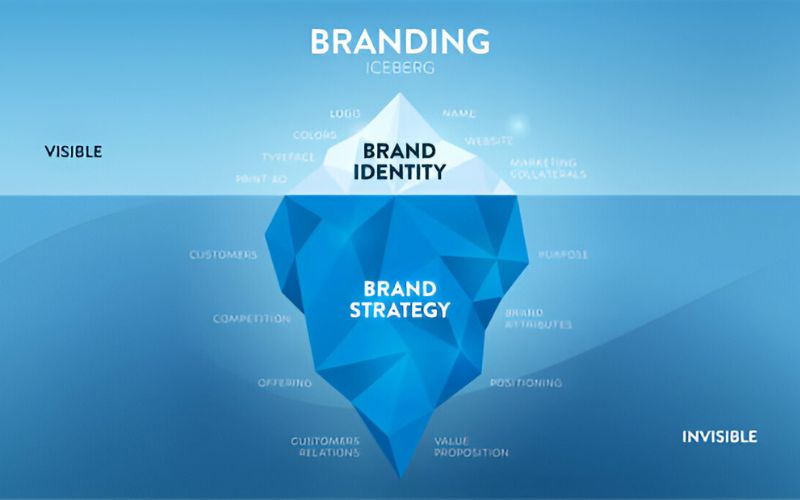Brand positioning framework can be described as both an art and a science that defines how a brand’s reputation can be defined by its customers in the market.
It is a vital element of any business strategy that influences the consumer’s opinions, driving purchase options and ultimately determining the course of a company’s growth.
In this blog, we’ll look at ten efforts and tested strategies successful brands use to establish and strengthen their brand positioning strategies.
What is Brand Positioning?

Brand positioning is the art of creating a different appearance and identity of a brand within the market. It is the process of identifying the distinct benefits of the brand and then communicating that to specific people in a way that matches them.
Why Brand Positioning is an Important Element?
Brand positioning is extremely important due to a myriad of reasons:
- Differentiating Yourself from the Crowd: It’s akin to making your brand have its distinct place in an extremely competitive market. If you promote your business well, consumers can distinguish it from other brands available.
- Making it Personal: Do you ever feel attracted to a company like the long-lost friend you’ve always had? That’s what happens when you have a good positioning. People feel linked to your brand at the emotional and deep levels.
- Making Decisions Easier: Look at every choice we have while purchasing. Brand positioning can help us make decisions by telling us why a particular label is an accurate choice.
- Being Noticed and Remembered: If your company’s name is properly placed, It’s like a light that shines in the darkness. The people who see it notice it and return to see more. This is like having a superpower to be noticed!
Types of Brand Positioning Framework Strategies

Strategy for Positioning in Customer Service
The art of creating a memorable customer experience isn’t only concerned with keeping people happy. It’s an excellent way to stand apart from other businesses.
Look at major brands like Zappos and Ritz-Carlton. They’ve done it right by going over and above regarding customer service. Here’s how:
- Moving Above: It’s more than about solving issues; it’s about wowing customers with surprising gestures. Zappos is one example. They recently sent flowers to a customer’s mother, who was hospitalized. Talk about going that extra distance!
- Generating Raving Fans: When you treat clients as VIPs, they will become your most enthusiastic supporters. Ritz-Carlton is known for its unparalleled service that turns guests into long-term followers who rave about their experience to all who will listen.
- Building Trust and Loyalty: Excellent service creates trust, which builds trust and loyalty. If customers are confident that they can trust your company to provide great service on every occasion, they’ll come back to experience even more. This is how you can transform a once-buyer into a long-term brand ambassador.
- Standing Out: You have the secret weapon among an ocean of ordinary outstanding service. That’s why people prefer your business over others, even when it involves spending a bit more. If you place a premium on customer satisfaction, it’s not about offering a service or product but a complete experience. It’s worth it.
Strategy Positioned on Convenience
Like superheroes, companies focusing on ease of use fly into the fray to relieve the busy consumer. Consider giants such as Amazon and Uber. They’ve learned their art of making your life more convenient by offering speedy and easy-to-use services that can fit into busy agendas.
They’ve established themselves as the go-to options for reducing time and energy. These companies have become essential in contemporary life. It doesn’t matter if it’s ordering food with just a swipe of your mobile or catching a taxi in seconds; convenience companies are focused on making our lives easier and giving us more time to enjoy what we enjoy.
Strategy Focused on Price Positioning
Price positioning focuses on giving you the most bang for your buck by offering priced products or services to give the competition a chance to compete for dollars. Look at the big names like Walmart and Aldi; they’ve perfected their art of establishing themselves as the top choice for finding affordable bargains.
By keeping their costs low and quality top-notch, they’ve become the top choice for consumers looking to maximize their money. No matter what the item is, whether it’s everyday necessities or high-end items, cost-conscious brands understand that providing the best price is essential to gaining the trust of consumers with a budget.
Strategy for Quality-Based Positioning
Positioning based on quality is important, as it raises the bar to offer products and services that surpass the competitors. Take industry leaders like Apple and Mercedes-Benz–they’ve earned their stripes by consistently offering top-notch quality that speaks for itself.
No matter what it is, whether cutting-edge technological advancements or luxurious cars, they’ve become known for their excellence and have earned premium prices as a result. High-quality brands gain credibility and respect among customers who want nothing less than the desirable through a focus on innovation, craftsmanship, and a keen eye for detail.
Strategy for Differentiation
Differentiation highlights what distinguishes your company from other brands by emphasizing unique benefits or advantages that rivals cannot beat. Consider big brands like Nike and Coca-Cola. They’ve conquered the competition by creating a strong identity and innovative advertising that draws the attention of others.
It doesn’t matter if it’s Nike’s famous logo or the timeless appeal of Coca-Cola. They have carved their niches in the market and have made themselves instantly recognizable and attractive to consumers. By daring to be different and staying ahead of the curve, differentiation-focused brands capture hearts, minds, and market share like nobody else.
Positioning Strategy via Social Media
Utilizing social media as an effective positioning strategy could transform how brands seek to establish their presence. Look at the trailblazers such as Wendy’s and Oreo. They’ve learned the art of connecting to the public and showing off their style on social platforms like Twitter and Instagram.
With their sassy tweets and mouthwatering content, these brands have attracted attention and earned themselves a steady following on the web: social media. Whether witty chatter or gorgeous images, using social media allows companies to show their personalities, establish connections, and create an identity recognizable to their target audience.
It’s as if you have an immediate connection to your audience, and each post allows you to shine and sets you apart from your competitors.
Additional Positioning Strategies
Alliances and Strategic Partnerships
Collaboration with brands that complement one another is a great approach to enhancing the brand’s image and increasing the reach of its offerings.
When collaborating with similar companies, brands can explore emerging markets, collect access to diverse customer segments, and build on each other’s strengths to develop innovative products that stand out from the crowd.
Positioning: Local vs. Global
Whether a brand establishes its business locally or internationally depends on the target market and its general business objectives. Local businesses are typically focused on catering to particular geographic areas’ specific requirements and preferences.
By tailoring their goods or offerings to local tastes and culture, these companies can establish strong relationships with their customers and develop a brand identity within their respective communities.
In contrast, global brands strive to reach a wide population spanning several countries and continents. With a focus on the universal themes, values or the product’s features, international brands seek to build a cohesive image appealing to customers worldwide.
This helps them profit from the benefits of scale, connect with more customers, and maintain the same brand identity across different market segments.
How to Formulate a Brand Positioning Strategy – 13 Steps

The process of creating a brand positioning strategy requires several stages:
1. Creating a Brand Positioning Strategy
Find out your ideal customer, your distinctive selling concept, and your brand’s personality.
2. Determining Your Current Brand Position
Conduct market research to determine what consumers and rivals think of your brand’s current position.
3. Developing a Brand Essence Chart
Determine the fundamental qualities and values that form your brand’s essence and determine your brand’s positioning.
4. Identifying Competitors
It is important to identify indirect and direct competitors in your sector and examine the positioning strategies of their competitors.
5. Conducting Competitor Research
Find information about competitors’ strengths, weaknesses, and market positions to find potential opportunities to differentiate.
6. Defining Your Unique Value Proposition
Define what makes your brand different and why consumers should prefer your company over other brands.
7. Building a Brand Positioning Framework
Make a brand positioning framework strategy that describes how your company is positioned within the marketplace and the primary message you intend to convey to your customers.
8. Crafting Your Positioning Statement
Clearly describe your brand’s distinctive value proposition and position on the market.
9. Assessing the Effectiveness of Your Positioning
Examine consumer opinions, sales, and brand metrics to determine the efficacy of your branding strategy.
10. Establishing an Emotional Connection with Prospects and Customers
Make emotional connections with your customers by telling stories, engaging in branding experiences, and engaging in social engagement.
11. Emphasizing Your Brand’s Differentiating Qualities in the Sales Process
Training sales and customer service teams to energetically convey your company’s distinctive benefits and unique selling points to customers.
12. Creating Value
Provide value to customers with innovative products, outstanding customer service, and compelling brand experience.
13. Ensuring Customer-Facing Employees Represent Your Brand
Instruct employees to reflect on your company’s values and favor consistently consistent experiences for clients at every point of contact.
Famous Brand Positioning Framework Through Example
We will examine how famous brands have positioned their products in the marketplace.
Apple vs. Samsung

Apple and Samsung define their market positions distinctly: Apple emphasizes high-tech innovation and design with a loyal, trend-conscious consumer base, while Samsung offers a broad range of products from budget-friendly to high-end, focusing on affordability and accessibility.
Starbucks vs Dunkin
Starbucks claims to offer a top-quality coffee experience, whereas Dunkin’ focuses on affordability and convenience.
Target vs. Walmart
Target is positioned as a fashionable retail store, whereas Walmart concentrates on affordable prices and many goods.
WordPress vs. Showit
WordPress is an adaptable and flexible website platform. Showit web designing is focused on offering users a drag-and-drop user interface that is easy for creative professionals to use.
Explore our in-depth comparison of Showit and WordPress to discover which platform best suits your needs.
Airbnb vs. Vrbo
Airbnb claims to be an open platform that offers unforgettable travel experiences. Vrbo concentrates on providing holiday rental homes for family and group bookings.
Taco Bell vs Chipotle
Taco Bell positions itself as a fast-food establishment that provides inexpensive Mexican food, while Chipotle is focused on high-quality, fresh ingredients and menus that can be customized.
Zara vs. H&M

Zara is positioned as a fashion retailer that offers stylish and affordable clothes; in contrast, H&M is focused on the environment and ethical style practices.
What is the Quality and Price-Based Positioning Strategy?
The strategy of positioning photography brand based on price and quality includes offering services or products that are perceived to be quality and reasonably priced.
This approach aims to attract customers who are willing to pay more for higher quality but also want it affordable.
How Do You Write a Brand Positioning Statement?
A statement of brand positioning must be concise, clear and memorable. It must convey the distinctive benefits of the brand as well as its place in the marketplace.
Here’s a sample for writing an effective brand positioning statement.
“Our brand is the excellent [adjective preference for our target audience that have a need or a problem] due to “We have a unique value proposition. Contrary to our competitors, our brand is distinguished by [value proposition[point of differentiation].”
Conclusion
Overall, the road to good positioning for a brand requires all-around thinking, which must satisfy the company philosophy, the interests of the target audience, and the nature of the market operation.
As organizations apply the strategies laid out in the article, they can differentiate themselves from the market and have a tremendous effect on the market by creating long-lasting customer relationships.
It doesn’t matter whether they will consider obvious product quality, prices, or convenience as their competitive advantage or apply sophisticated techniques like strategic partnerships and social media.
It makes the brand stand out from the crowd and attracts the right customer to stick with it. The company has to form a unique brand image that the clients can identify. Competition plays a big role here.